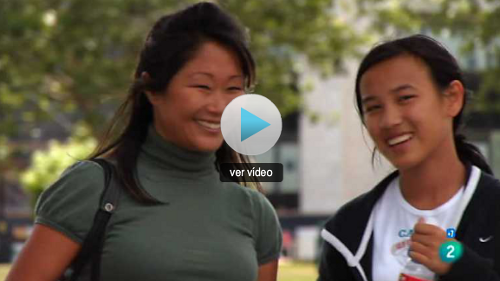Label: movies
Child sexual abuse: how to make the data visible
18 February 2016.
Tags: abuse, research, maltreatment, movies, protection, Releases, awareness, sexuality, violence
In recent weeks the issue of child sexual abuse, which has been from the beginning of CI Espirales one of our priority areas of work, It is gaining relevance in public and social agenda. This type of decision-awareness of a problem it is necessary to provide them with reliable data and rigorous arguments. And in the case of child sexual abuse, both elements are incontestable.
In recent weeks we have had access, thanks to the extraordinary work done in Soledad Sánchez Blog Service to Children and Adolescents the Aragon Institute of Social Services (We mentioned an entry in our blog some years ago), two publications that we want to echo that provide as rigorous as shocking data on this issue.
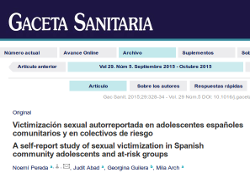 The first is a study by Naomi Pereda and collaborators (Judit Abad, Georgina Guilera y Mila Arch) and published in the Gaceta Sanitaria, volume 29, number 5 of 2015, qualified “Community self-reported sexual victimization in Spanish adolescents and groups at risk”. Léanla. Collect a large sample of adolescents, both EU population, as seen in child and adolescent mental health centers, or living in shelters and centers reform. Attend to the data from the questionnaires that have happened reporting of different forms of sexual victimization:
The first is a study by Naomi Pereda and collaborators (Judit Abad, Georgina Guilera y Mila Arch) and published in the Gaceta Sanitaria, volume 29, number 5 of 2015, qualified “Community self-reported sexual victimization in Spanish adolescents and groups at risk”. Léanla. Collect a large sample of adolescents, both EU population, as seen in child and adolescent mental health centers, or living in shelters and centers reform. Attend to the data from the questionnaires that have happened reporting of different forms of sexual victimization:
The extent of sexual victimization ranges from 14,7% throughout the life of the total community sample, a 23,5% in / the youth served / as in mental health, a 35,6% of / the young people involved / as in the juvenile justice system and 36,4% of / the children treated / as by the protection system. There is a majority of female victims, except under juvenile justice.
And there are more data on the polivictimización, about age differences, gender… Read it. They are all Spanish adolescents. And perhaps reading studies like this one may look somewhat different from adolescents to being served in the protection system, but especially those who are cared for in the juvenile justice system.
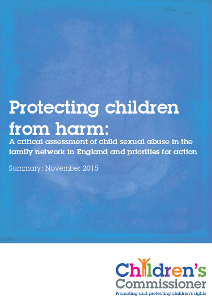 The other study is that we want to echo UK, by the office of the Commissioner for Children of England. Its titled Protect children from danger: A critical assessment of child sexual abuse in the family in England and priorities for action (Protecting children from harm: A critical assessment of child sexual abuse in the family network in England and priorities for action – Children’s Commissioner for England) and it was published in the UK in November 2015. In this case, The study focuses on the prevalence of child sexual abuse in the family in England. It also speaks, and among other chilling details, of a 11,3% teenagers in England who report experiences of child sexual abuse in their family environment.
The other study is that we want to echo UK, by the office of the Commissioner for Children of England. Its titled Protect children from danger: A critical assessment of child sexual abuse in the family in England and priorities for action (Protecting children from harm: A critical assessment of child sexual abuse in the family network in England and priorities for action – Children’s Commissioner for England) and it was published in the UK in November 2015. In this case, The study focuses on the prevalence of child sexual abuse in the family in England. It also speaks, and among other chilling details, of a 11,3% teenagers in England who report experiences of child sexual abuse in their family environment.
But in addition to data, to achieve public visibility of this problem, It is necessary to develop social awareness materials, and that victims can speak and tell their stories. If we can not get data from studies disseminate existing today and many others face and take, history, humanity, society will never own and react to them. The problem is that children, and adolescents can not speak alone, They need support to stop being figures only read studies that we work with them.
Just a few weeks ago we echoed one of these narrated the first person by a victim as an adult stories, which he recounts in his book James Rhodes Instrumental. Associations adults who were abused in childhood play a key role in this process, we must support and promote. It is his voice that should be heard.
And in this sense, Today we want to echo two films we've seen in recent weeks and are mandatory when working on this issue.
The first and most diffusion is taking is Spotlight, directed by Tom McCarthy, which tells the team work of journalists who uncovered the cover-up of the Archbishop of Boston of sexual abuse by several priests of his diocese. The film told through the experience of journalists, his vision of what they discovered, the horror and pain of the victims, and silence extended far beyond what might seem. A heavy silence that extends the boundaries of responsibility for what happened beyond the priests themselves.
The other film is The club, a Chilean film directed by Pablo Larraín. It is a film that hurts to see. Tells the story of several priests removed from work for various reasons. The performances are unique and reflect what are horrors that we are responsible not forget.
Child sexual abuse is a reality. And the only way to prevent and eradicate it is to name and denounce. The silence of our societies and the lack of training and appropriate intervention by our institutions are the second and third form of victimization to those children that we did not know, we could or wanted to protect. And that victimization does not end with childhood. If not named, if not viewed from the front, lifelong. And it destroys.
Documentary “New Girls 24 hours” Mabel Lozano on human trafficking
9 September 2015.
Tags: abuse, rights, human rights, documentary, gender, advocacy, justice, maltreatment, movies, protection, awareness, is, violence
Shocking. Uncomfortable. Essential.
The last friday, 4 September 2015, It was the official premiere of the documentary in Madrid “New Girls 24 hours”, (@chicasnuevas24h) directed and co-produced by Mabel Lozano (LozanoMabel). Since Spiral Consulting Children spent years working to prevent, detection and intervention in cases of is of children, girls and adolescents for sexual exploitation and know Mabel Lozano's work in this area. So I bought my ticket to the premiere and the subsequent discussion with the principal and other personalities. I left shocked and at the same time with some satisfaction at the results, Despite the hardness of the subject: to have a new material, so valuable, and because it is taking so popular (tickets to the premiere and the next day sold out, social networks are very active in this regard, the public is composed not only by professionals in the field but also by the general public knows so an issue as invisible).
You can see the main trailer to get an idea, in which you can identify its main features.
First, It is a documentary Shocking. Relates directly extreme violation of children, adolescent and adult sexual exploitation within the trafficking networks, and that always hits. It combines the great figures (trafficking in Spain moves daily about five million euros, moves around the world 32.000 million annually…) with concrete stories of girls and women exploited within their own country (intra deals) and out (international trafficking). And details
It is also a documentary uncomfortable. For details that trafficking in persons is not a matter of a few criminals, but there are many sectors of society that profit while closing their eyes (major newspapers with ads of contacts that the victims never would write, Travel agencies, taxi drivers, municipalities to tax the supposedly local “voluntary alternate”), and especially the misnamed “customers”, to Rocio Mora, the APRAMP, It is given in the name of the documentary “prostituyentes” (if there was no demand, there would offer).
And it is certainly a documentary essential. Because despite the harshness of the subject, not enter any moment in the rough. In fact, as said the director herself in the subsequent discussion the premiere (and appears on your website), in Paraguay they are translating the entire documentary Guarani and they will be mapped to all secondary schools in the capital, as prevention, and since it is also preparing the translation into Quechua to carry educational and social centers Peru. He trafficking for sexual exploitation is not an issue of sex, or at least it should not be seen as well: it is an issue of violation of basic rights, it is an issue of slavery and mistreatment. And it's a matter of money (It is among the three most lucrative illegal business, beside the arms trade and drug trafficking).
Anything to improve? The documentary is clearly oriented from a gender perspective, which it is essential in the phenomenon of trafficking for purposes of sexual exploitation, since the majority of sufferers are women and girls and the vast majority of those charged are men, and it is suitable. But, What about children and adolescents, who they are also victims of trafficking for sexual exploitation, and even some adult men are also exploited? I would have liked that at least they would have mentioned also, so that young boys do not become invisible in invisible.
Since Spiral Consulting Children wish him all the best documentary, and hope it can be affordable in multiple formats in many places.
And while we encourage you to watch the trailer, to investigate the news of his web (many opinion articles have very enriching) and be aware of your local billboard, to see when it premieres.
It is continuing to create awareness.
Upgrading to 23 September 2015, International Day Against the Sexual Exploitation and Trafficking: the entrance “Focusing and Nonviolent Communication to repair the sexual exploitation” It offers new ideas.
The transmission of values in children
1 July 2015.
Tags: affectivity, cuentos, education, parents, for children, movies, videos
Values are part of our essence, are our rules of conduct that allow us to conduct ourselves according to what we believe is right or wrong.
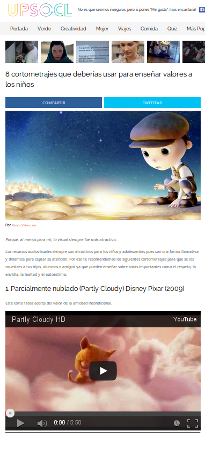 Mothers and fathers are directly responsible for the transmission of values to our children, and the main way to do this is by example. Our behaviors, our speech and direct others, our tolerance and fellowship, among other things, are the ways that children learn to value their behaviors and those of others.
Mothers and fathers are directly responsible for the transmission of values to our children, and the main way to do this is by example. Our behaviors, our speech and direct others, our tolerance and fellowship, among other things, are the ways that children learn to value their behaviors and those of others.
Besides values education helps improve relationships based on mutual respect and allows us to feel comfortable in the environment we live.
Now that the holidays begin and we have more time to spend with our children I would like to share 8 short films to teach values (such as friendship, team work, respect the rights of others, gender equality, achieve what you want) compiled by UPSOCL, a website that collects and disseminates inspirational videos that we follow and we've recommended in the past, and seize this moment to talk and know what our children think about it. I'm sure many of us we will surprise us your comments.
I hope you enjoy these videos and holidays.
Regards,
Lucia Losoviz
Movie “The lives of Grace” (“Short Term 12”) Destin Daniel Cretton
3 February 2015.
Tags: affectivity, interpersonal communication, rights, education, maltreatment, movies, protection, videos, links, violence, experiences
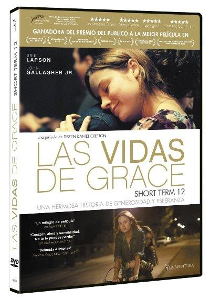 See the work in the therapeutic and social field from fiction can give us many clues to reflect on. The film Short Term 12 (the 2013 US), titled in Castilian The lives of Grace (2014 in Spain), collected from fiction usual aspects of psychosocial intervention protection
See the work in the therapeutic and social field from fiction can give us many clues to reflect on. The film Short Term 12 (the 2013 US), titled in Castilian The lives of Grace (2014 in Spain), collected from fiction usual aspects of psychosocial intervention protection
The director of this moving film, Destin Daniel Cretton, just after his career he spent two years working in a temporary shelter for adolescents at risk (hence the title, “Short Term 12”, which refers to the alleged “short”, although some years with). When a few years later completed a master's degree to become a filmmaker, He gave a short to this topic. Was so well received that ultimately wrote and directed this film, which in turn has been very well received by critics and the public. I knew of its existence thanks to blog “Designing past, future remembering” F. Javier Soriano Romeu, and recommend that in another post.
Without too, I can avanzaros the film chronicles a few days in a shelter “temporal” for adolescents with social risk (abuse or neglect their families, criminal activities, Substance, psychological disorders…), background and reflection focuses on how to help them get ahead themselves. Grace is an educator who manages the youth are linked with it, within their means, which invites us to reflect on the importance of linking with the boys and girls with whom we work. We also see other professionals (other educators, director, social worker…) we raised our own teamwork and within our teams. Addition, we envision the personal life of Grace, with its lights and shadows, and how both parties shape their interventions (Are we aware of how our lights and our shadows influence us in our actions?). And all with various ethical dilemmas, personal and professional, leading to the importance of caring for the caregiver.
Con un rhythm alternating (sometimes very fast, as is the reality of conflict intervention; sometimes very slow and thoughtful, as young people need to be heard), history engages and gives clues to see how we are working from the professional from the personal, with an invitation to hope, from our imperfections. My recommendation is to see and comment professionals within our teams in relation to their work and their experiences, and that just came out on DVD.
I wish you a successful and viewing direction. And if you have any movie more than you wish that we recommend, You can let us know in comments or on our email.
Javier
Video “ReMoved” on fostering
10 September 2014.
Tags: ADOPTION ³ n, affectivity, maltreatment, movies, protection, awareness, videos, links, experiences
The short one “ReMoved”, the marriage formed by Nathaniel Matanick (Heschle) and Christina Matanick, and award-winning short, It reflects the experience of a child victim of domestic violence which is supervised with his brother by the system of protection and enhancement successive foster homes.
[You can enable subtitles in Spanish or English with YouTube controls]
Reflects short and shocking way the suffering of the girl, dissociation mechanisms developed and the breakdown of emotional connection to the world you need to do to survive. It also reflects the origin of what we often call “disruptive behavior”.
It is difficult to find materials awareness so crudely reflecting the pain of the victims, and that's what they get Nathaniel and Christina Matanick, who set out to reflect what they learned in their training as host family, as told in interview (English). From Spirals CI in formations we do always try to just visualize that pain, to the professionals and institutions to develop interventions that fit their suffering and give priority over other interests or needs.
In this sense, videos like this make our work much easier.
Joe
Adoption Documentary: “Between two worlds”
20 May 2013.
Tags: ADOPTION ³ n, affectivity, documentary, research, parents, movies, protection, awareness, links
How do you feel an adolescent adopted at the physical differences with his adoptive family? What positions adopted girls born in China but educated by American families? How does it affect your personal story in their own development, in their expectations and hopes?
La directora Linda Goldstein Knowlton, mother of a child adopted from China, arises what happens to other girls like yours when they reach adolescence. The documentary “Between two worlds” (English “Somewhere Between”) is the response to your inquiry: portrays the different processes adopted four teenagers living in China for American families, what difficulties they encounter in their daily life and what challenges face to build your identity.
It is fortunate to have the full documentary dubbed in Castilian in Documents TV, recommend that you veáis soon, while available online.
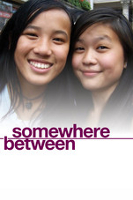 If you want to know more about the whole process of filming, recommend that it veáis interview with the director (English only), commenting on his own personal life with her adopted daughter and relationships with young women featured in the documentary. You can also investigate the documentary website (English), which give the details of the current status of each of the protagonists, and interesting links.
If you want to know more about the whole process of filming, recommend that it veáis interview with the director (English only), commenting on his own personal life with her adopted daughter and relationships with young women featured in the documentary. You can also investigate the documentary website (English), which give the details of the current status of each of the protagonists, and interesting links.
Whether Tene NIÑAS the nests that have gone through an adoption process as it is in contact with teens, this documentary helps to reflect on the emotional bonds and the construction of identity throughout adolescence.
Hope you like it.
Javier
Patterns of gender identities that offer movies
2 April 2013.
Tags: affectivity, gender, parents, movies, awareness, sexuality, videos
The talks TED Talks are is often as interesting as inspiring. They take us to different places but always involve reflection.
In this case, Colin intervention Stokes, Brand Communications Director&Comunications reflects on the models that provide children's movies children.
This time also, especially the emphasis on models of masculine identity that offers children and the role that these children as adults can have on the social transformation.
Stokes discusses some heroes and heroines of popular movies, reflecting content and very different life goals and provide a whole view of the world and their role in it.
From CI Spirals consider essential reflection on the creation of gender identities in raising children. Not only in what touches family models, but the role of families in the face of challenge models provided to them in the media.
We hope that this video will be as interesting and useful to the conversation in your families as it has been for us.
Javier and Pepa
Child Series “Kipatla” for sensitization against various forms of discrimination
13 March 2013.
Tags: interpersonal communication, disability, education, for children, movies, poverty, protection, awareness, videos
The CONAPRED, National Council to Prevent Discrimination of the Ministry of the Interior of the Government of Mexico, has developed an outreach program for children called Kipatla (the fictional place where all stories are developed called “Change” in the Nahuatl language).
It is a series of chapters featuring children that reflect different forms of discrimination experienced by children from different groups in your country.
The chapters reflect gently but clearly and with a constructive approach to positive resolution different violations of children's rights.
Although the contents are based on the Mexican reality, are videos that can be easily extrapolated to the reality of our countries and families can see easily with children and from there to talk about the different problems.
Apart from this entrance is inserted into more, dealing with a positive approach integrating all aspects (of the sensory motor disabilities, of ethnic or religious differences, disadvantages such as HIV / AIDS or poverty…) . You can see the complete series here. We hope that the fruit of wide conversation on changing vision of the problems faced by children in their everyday and their possible solutions.
Javier and Pepa
Trafficking Movie: “Human Trafficking”
4 October 2011.
Tags: abuse, maltreatment, movies, awareness, is, violence
Another movie very useful to understand the phenomenon of child trafficking, and adolescents with sexual exploitation Human Trafficking, translated into Castilian as “Human Trafficking”, although the correct translation would be “Human Trafficking”. The confusion of terms when translating from English to Castilian is often, and therefore it is important to note that the term “Traffic” corresponds to the English “smuggling” (people who are trafficked are at normal according, and pay for the service of the gangs that lead to other countries), and “is” is the correct term to translate “traffic” (people who have it do not always leave a country, and consent to the final activities, though first time may agree with the proposals (false) that they had done).
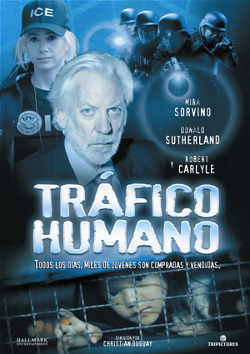 The film, conceived as a miniseries, tells what happens when a seventeen-year-old from Ukraine, Czech single mother and an American girl of tourism in the Philippines are victims of a network of trafficking for prostitution. A team of agents from the Immigration and Customs struggle to expose the organization which coordinates the network.
The film, conceived as a miniseries, tells what happens when a seventeen-year-old from Ukraine, Czech single mother and an American girl of tourism in the Philippines are victims of a network of trafficking for prostitution. A team of agents from the Immigration and Customs struggle to expose the organization which coordinates the network.
The film provides an overview of policing (within the U.S. legal framework) against the Mafia as well as displays various kinds of human dramas (victims, their families, different levels of interventions traffickers and security forces. For its duration allows a better understanding of different processes, both the victims and traffickers, giving a fairly complete picture of the problem.
The film has no official website, but you can find much data on it in the Wikipedia entry (English).
Reference (in Spain): Human Trafficking (Human Trafficking) / Christian Duguay; Madrid : TriPictures, DL, 2005.
Essential to glimpse the complexity of the problem of child trafficking, children and adolescents for sexual exploitation. Hope you like it.
Javier
Book and film deals: “The year that trafficked women”
4 October 2011.
Tags: abuse, maltreatment, movies, awareness, is, violence
The issue of child trafficking, children and adolescents for sexual exploitation has long been insufficient attention in Spain. Among the few works aimed at the general public about trafficking in Spain are the reviews on this entry.
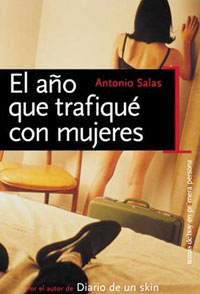 The journalist identified as Antonio Salas conducted research on trafficking in persons for sexual exploitation in Spain 2003, he picked up in a TV report with hidden camera recordings in the book The year that trafficked women (Today's Issues, Madrid, 2004).
The journalist identified as Antonio Salas conducted research on trafficking in persons for sexual exploitation in Spain 2003, he picked up in a TV report with hidden camera recordings in the book The year that trafficked women (Today's Issues, Madrid, 2004).
Tells them how he posed as pimp, local knowledge of alternate throughout Spain, research from prostitutes working in street prostitution to luxury, to describe the reality of trafficking in Spain. Both the book and the story are very hard, with the aggravation of knowing that the people featured are real, although some data have changed or have pixelated the faces. Especially interesting is the fact of putting names and stories to what is usually seen as global data and statistics.
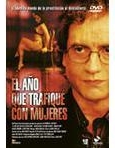
The year after the publication of the book the film was made with the same name, with a script that leaves only some elements of original research. It has the advantage of providing an overview of trafficking for sexual exploitation in Spanish society, but is more focused on traffickers and victims and clients unless.
Reference: The year that trafficked women / Jesús Font; [Barcelona] : DeAPlaneta Home Entertainment, 2005.
I hope you find it of interest.
Javier


